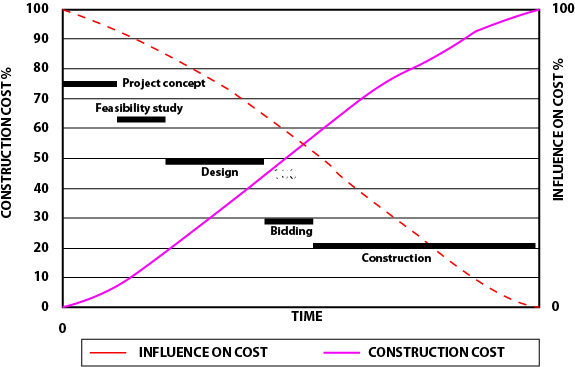Pre-Design Phase
At the pre-design and design phases, the ability to influence the cost of the project is the highest, and the cost of project modification is lowest, as shown in the figure below. This is especially true for small jobs where the contractor's cost savings (from design modification) is small in magnitude, and the benefits do not justify the risk of being responsible for the redesign and its consequences. Therefore, invested effort in this phase will pay dividends later.

The pre-design phase involves collecting information about the old and new pipelines. For example, potential solutions may include installing another new line, lining the old pipe, replacing the pipeline via open cut, replacing it by pipe bursting, etc. If pipe bursting is the optimal solution, the design team proceeds to the design phase. This phase also includes investigating potential solutions for the problem and collecting the relevant information to evaluate the valid solutions. For example, potential solutions may include installing another new line, lining the old pipe, replacing the pipeline via open cut, replacing it by pipe bursting, etc. If pipe bursting is the optimal solution, the design team proceeds to the design phase.
Open cut is the often specified method of construction for most pipeline projects, and the bursting contractors offer pipe bursting as an alternative. This process may include preparation and submittal of two bids: one based on open cut and the second a value-engineering proposal based on pipe bursting. While this arrangement may increase the competition among bidding contractors, it increases the overall project cost (due to risk and contingency factors) for the project because (1) while the presented information in the contract document might be complete for the open cut method, it may be incomplete for estimating the cost of the bursting project and (2) this incomplete bid information increases the risk of problems during construction period that may lead to change orders and possible disputes that are more costly to resolve. It is believed that if the owner and the engineer select the methods of construction (for example open cut vs. pipe bursting) early during the design phase, the competition is maintained, bidding information is complete, and the risk of changes is reduced as illustrated in the figure.